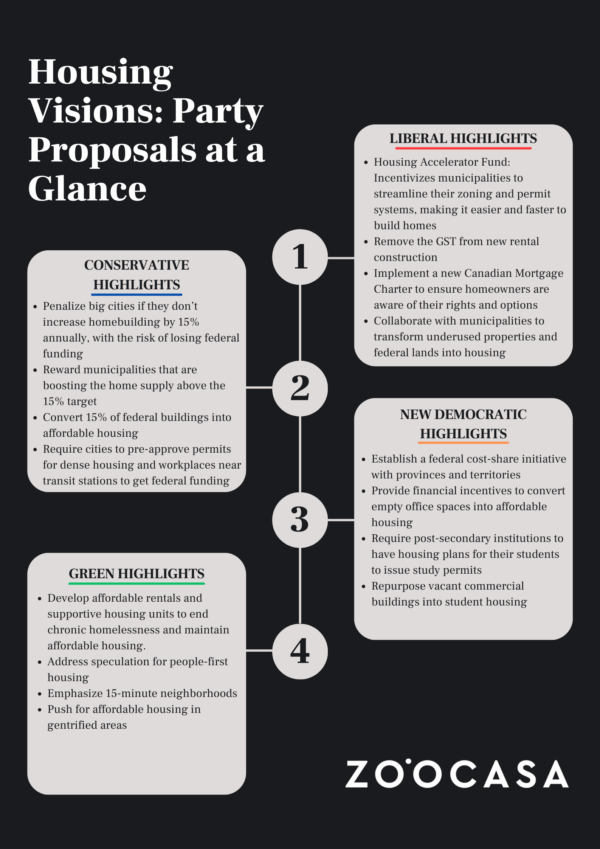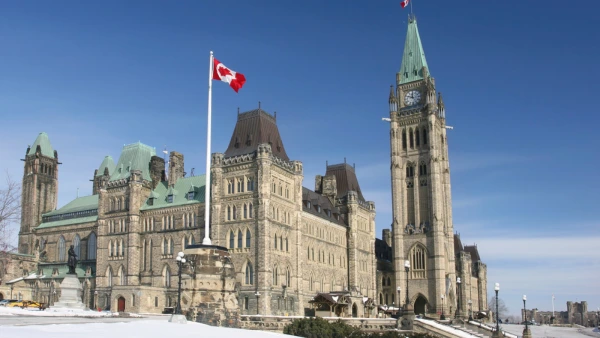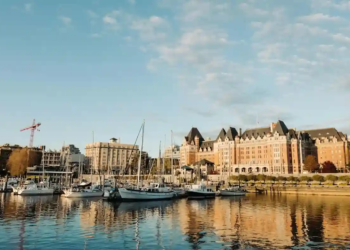Rising interest rates, an undersupply of homes, and a cost of living crisis are making homeownership increasingly difficult for many Canadians. Low inventory has long been linked with pushing home prices upwards across Canada. When there are fewer homes on the market, buyers are forced to compete for a smaller number of homes which leads to an increase in price. High population growth, driven by inter-provincial migration in some areas and international immigration in others, has been connected with exacerbating the country’s housing supply. There are also other factors impacting the housing market such as high borrowing costs, slow income growth, and labour shortages.
Regardless of the driving force, across cities and provinces, housing affordability is a complex issue with not one governing body responsible for solutions. With that being said, municipalities need to work with government bodies to be aligned in finding housing solutions for Canadians. So what are each political party’s proposals for addressing Canada’s housing challenges? Here are the key takeaways from each political party:
Enjoying our content? Subscribe to our free weekly newsletter to get real estate market insights, news, and reports straight to your inbox.
*For the line graph, new listings data from January, April, July, and October was used in each year. Data was sourced from the Canadian Real Estate Association (CREA).
The Liberal Party
The Liberal’s primary housing initiative is the Housing Accelerator Fund - a $4-billion fund aimed at growing the housing supply in major cities by encouraging municipalities to streamline zoning and permitting processes. The hope is that this will promote faster residential construction and will lead to 100,000 new middle-class homes by 2024-2025.
Several cities have already signed deals with the government under the Housing Accelerator Fund, including London, Vaughan, and Burlington. The Liberals have also announced that they will eliminate the GST from new rental housing and will work with municipalities to identify vacant properties that could be converted into housing.
In the Fall Economic Statement (FES) in 2023, the Liberals said they would implement a new Canadian Mortgage Charter to help homeowners access support and relief. Though the charter is not a law, it is a list of expectations for lenders to follow. Some of these expectations include waiving fees and costs that would have otherwise been charged for relief measures and requiring banks to contact homeowners four to six months in advance of their mortgage renewal.
The Conservative Party
The Conservative's approach to housing places emphasis on removing bureaucratic gatekeepers and boosting homebuilding efforts. Rather than incentivizing cities, the Conservative housing plan focuses on penalizing big cities that don’t hit homebuilding targets. The plan would require cities to increase homebuilding by 15% annually, with the risk of losing federal funding if not reached.
Similar to the Liberal Party, the Conservative Party has also announced that they would eliminate the GST on affordable apartment housing, however, the rebate would only be given to properties where the median rent is below market value.
Another emphasis of the Conservative housing plan is on removing gatekeepers so that homes can be built at a faster rate with less bureaucracy. As well, cities that want to get federal funding would be required to get pre-approved permits for dense housing and workplaces near transit stations.


New Democratic Party
The New Democrats' (NDP) approach to housing focuses on ensuring that more affordable rental and housing units are being built. They propose setting up fast-start funds for co-ops, social, and non-profit housing and using federal resources and lands for these projects.
NDP also emphasizes getting more student housing built by repurposing vacant commercial and office buildings into student dormitories. Another suggested solution for student housing by the NDP is to require post-secondary institutions to have housing plans for their students to receive study permits. The creation of a student housing funding plan, with equal contributions from the federal government, provinces, territories, and educational institutions, has also been suggested by the NDP.
The Green Party
At the beginning of 2024, the Green Party announced its resolutions for the Liberal government and what it hoped to see for the new year. Establishing a guaranteed minimum income was one such point made, with the hopes being that this would help eliminate poverty and lead to more affordable housing. Ending systemic poverty is a key value for the Green Party and this ties into the Green Party’s “people-first” housing approach which aims to increase access to housing for those experiencing chronic homelessness.
The Green Party emphasizes the right to safe and affordable housing for all Canadians and advocates for the construction of more affordable housing units, intending to double the current social housing stock. The Green Party of Ontario specifically pushes for affordable housing in gentrified areas, supporting renters on their pathway to homeownership, reducing speculation to put homes for people first, and creating connected, 15-minute neighborhoods.
If you’re thinking of entering the real estate market in the near future, give us a call! We can help you plan out your real estate future and answer your questions about the ever-changing market conditions.















